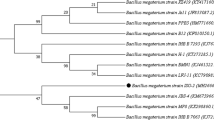Abstract
Bisphenol A (BPA) has been widely used in the manufacture of polymeric materials. BPA is regarded as an endocrine disrupting chemical, posing a great threat to the public health. In this study, a bacterial strain LM-1, capable of utilizing BPA as the sole carbon and energy source under aerobic conditions, was originally isolated from an activated sludge sample. The isolate was identified as Pseudomonas sp. based on 16S rRNA gene sequence analysis. Strain LM-1 was able to completely degrade 25–100 mg/L BPA within 14–24 h, and it also exhibited high capacity for BPA degradation at a range of pH (6.0–8.0). (NH4)2SO4 and NH4NO3 were the suitable nitrogen sources for its growth and BPA biodegradation, and the BPA degradation could be accelerated when exogenous carbon sources were introduced as the co-substrates. Metal ions such as Zn2+, Cu2+, and Ni2+ could considerably suppress the growth of strain LM-1 and BPA degradation. According to the analysis of liquid chromatography coupled to Q-Exactive high resolution mass spectrometry, hydroquinone, p-hydroxybenzaldehyde, and p-hydroxybenzoate were the predominate metabolites in the BPA biodegradation and the degradation pathways were proposed. This study is important for assessment of the fate of BPA in engineered and natural systems and possibly for designing bioremediation strategies.




Similar content being viewed by others
References
Cydzik-Kwiatkowska A, Zielińska M, Bernat K, Bułkowska K, Wojnowska-Baryła I (2020) Insights into mechanisms of bisphenol A biodegradation in aerobic granular sludge. Biores Technol 315:123806
Eio EJ, Kawai M, Tsuchiya K, Yamamoto S, Toda T (2014) Biodegradation of bisphenol A by bacterial consortia. Int Biodeterior Biodegradation 96:166–173
Fischer J, Kappelmeyer U, Kastner M, Schauer F, Heipieper HJ (2010) The degradation of bisphenol A by the newly isolated bacterium Cupriavidus basilensis JF1 can be enhanced by biostimulation with phenol. Int Biodeter Biodegrad 64(4):324–330
Frankowski R, Zgoła-Grześkowiak A, Smułek W, Grześkowiak T (2020) Removal of bisphenol A and its potential substitutes by biodegradation. Appl Biochem Biotechnol 191:1100–1110
Gao C, Zeng Y-H, Li C-Y, Li L, Cai Z-H, Zhou J (2022) Bisphenol A biodegradation by Sphingonomas sp. YK5 is regulated by acyl-homoserine lactone signaling molecules. Sci Total Environ 802:149898
Gu C, Wang J, Liu S, Liu G, Lu H, Jin R (2016) Biogenic fenton-like reaction involvement in cometabolic degradation of tetrabromobisphenol A by Pseudomonas sp fz. Environ Sci Technol 50(18):9981–9989
Gu C, Wang J, Guo MF, Sui M, Lu H, Liu GF (2018) Extracellular degradation of tetrabromobisphenol A via biogenic reactive oxygen species by a marine Pseudoalteromonas sp. Water Res 142:354–362
Huang YQ, Wong CKC, Zheng JS, Bouwman H, Barra R, Wahlström BW, Neretin L, Wong MH (2012) Bisphenol A (BPA) in China: a review of sources, environmental levels, and potential human health impacts. Environ Int 42:91–99
Ike M, Jin CS, Fujita M (1995) Isolation and characterization of a novel bisphenol A-degrading bacterium Pseudomonas paucimobilis strain FJ-4. Jpn J Water Treat Biol 31(3):203–212
Im J, Löffler FE (2016) Fate of bisphenol A in terrestrial and aquatic environments. Environ Sci Technol 50(16):8403–8416
Jia Y, Eltoukhy A, Wang J, Li X, Yan Y (2020) Biodegradation of bisphenol A by Sphingobium sp. YC-JY1 and the essential role of cytochrome. Int J Mol Sci 21(10):3588
Jin Q, Kirk MF (2018) pH as a primary control in environmental microbiology: 1. Thermodynamic perspective. Front Environ Sci 6:21
Kang JH, Katayama Y, Kondo F (2006) Biodegradation or metabolism of bisphenol A: from microorganisms to mammals. Toxicology 217(2–3):81–90
Li G, Zu L, Wong PK, Hui X, Lu Y, Xiong J, An T (2012) Biodegradation and detoxification of bisphenol A with one newly-isolated strain Bacillus sp. GZB: Kinetics, mechanism and estrogenic transition. Biores Technol 114:224–230
Lobos JH, Leib TK, Su TM (1992) Biodegradation of bisphenol A and other bisphenols by a gram-negative aerobic bacterium. Appl Environ Microbiol 58(6):1823–1831
Ma Q, Meng N, Li Y, Wang J (2021) Occurrence, impacts, and microbial transformation of 3-methylindole (skatole): a critical review. J Hazard Mater 416:126181
Masuda M, Yamasaki Y, Ueno S, Inoue A (2007) Isolation of bisphenol A-tolerant/degrading Pseudomonas monteilii strain N-502. Extremophiles 11(2):355–362
Matsumura Y, Hosokawa C, Sasaki-Mori M, Akahira A, Fukunaga K, Ikeuchi T, Oshiman KI, Tsuchido T (2009) Isolation and characterization of novel bisphenol-A-degrading bacteria from soils. Biocontrol Sci 14(4):161–169
Michałowicz J (2014) Bisphenol A-sources, toxicity and biotransformation. Environ Toxicol Pharmacol 37(2):738–758
Noszczyńska M, Piotrowska-Seget Z (2018) Bisphenols: Application, occurrence, safety, and biodegradation mediated by bacterial communities in wastewater treatment plants and rivers. Chemosphere 201:214–223
Noszczyńska M, Chodór M, Jałowiecki Ł, Piotrowska-Seget Z (2020) A comprehensive study on bisphenol A degradation by newly isolated strains Acinetobacter sp. K1MN and Pseudomonas sp. BG12. Biodegradation 32:1–15
Oshiman K, Tsutsumi Y, Nishida T, Matsumura Y (2007) Isolation and characterization of a novel bacterium, Sphingomonas bisphenolicum strain AO1, that degrades bisphenol A. Biodegradation 18:247–255
Peng YH, Chen YJ, Chang YJ, Shih YH (2015) Biodegradation of bisphenol A with diverse microorganisms from river sediment. J Hazard Mater 286:285–290
Poblete-Castro I, Becker J, Dohnt K, dos Santos VM, Wittmann C (2012) Industrial biotechnology of Pseudomonas putida and related species. Appl Microbiol Biotechnol 93:2270–2290
Reddy PV, Kim K-H, Kavitha B, Kumar V, Raza N, Kalagara S (2018) Photocatalytic degradation of bisphenol A in aqueous media: a review. J Environ Mange 213:189–205
Sakai K, Yamanaka H, Moriyoshi K, Ohmoto T, Ohe T (2007) Biodegradation of bisphenol A and related compounds by Sphingomonas sp. strain BP-7 isolated from seawater. Biosci Biotechnol Biochem 71:51–57
Sasaki M, Maki J, Oshiman K, Matsumura Y, Tsuchido T (2005) Biodegradation of bisphenol A by cells and cell lysate from Sphingomonas sp. strain AO1. Biodegradation 16:449–459
Seyhi B, Drogui P, Buelna G, Blais JF (2013) Biodegradation of bisphenol-A in aerobic membrane bioreactor sludge. Water Sci Technol 68(9):1926–1931
Shuttleworth KL, Cerniglia E (1995) Environmental aspects of PAH biodegradation. Appl Biochem Biotechnol 54(1–3):291–302
Skledar DG, Mašič LP (2016) Bisphenol A and its analogs: do their metabolites have endocrine activity? Environ Toxicol Pharmacol 47:182–199
Staples CA, Dome PB, Klecka GM, Oblock ST, Harris LR (1998) A review of the environmental fate, effects, and exposures of bisphenol A. Chemosphere 36(10):2149–2173
Telke AA, Kalyani DC, Jadhav UU, Parshetti GK, Govindwar SP (2009) Purification and characterization of an extracellular laccase from a Pseudomonas sp. LBC1 and its application for the removal of bisphenol A. J Mol Catal B Enzym 61:252–260
Zhang C, Zeng G, Yuan L, Yu J, Li J, Huang G, Xi B, Liu H (2007) Aerobic degradation of bisphenol A by Achromobacter xylosoxidans strain B-16 isolated from compost leachate of municipal solid waste. Chemosphere 68(1):181–190
Zhang W, Yin K, Chen L (2013) Bacteria-mediated bisphenol A degradation. Appl Microbiol Biotechnol 97(13):5681–5689
Zhang X, Jing J, Zhang L, Song Z, Zhou H, Wu M, Qu Y, Liu L (2019) Biodegradation characteristics and genomic functional analysis of indole-degrading bacterial strain Acinetobacter sp. JW. J Chem Technol Biotechnol 94(4):1114–1122
Zhang X, Song Z, Tang Q, Wu M, Zhou H, Liu L, Qu Y (2021) Performance and microbial community analysis of bioaugmented activated sludge for nitrogen-containing organic pollutants removal. J Environ Sci 101:373–381
Zhou NA, Kjeldal H, Gough HL, Nielsen J (2015) Identification of putative genes involved in bisphenol A degradation using differential protein abundance analysis of Sphingobium sp. BiD32. Environ Sci Technol 49:12232–12241
Zhu SN, Liu DQ, Fan L, Ni JR (2008) Degradation of quinoline by Rhodococcus sp. QL2 isolated from activated sludge. J Hazard Mater 160(2–3):289–294
Acknowledgements
This work was supported by the Fundamental Research Funds for the Central Universities (No. DUT19JC17) the Postdoctoral Advance Programs of Zhejiang Province (ZJ2021022).
Author information
Authors and Affiliations
Corresponding author
Additional information
Publisher’s Note
Springer Nature remains neutral with regard to jurisdictional claims in published maps and institutional affiliations.
Rights and permissions
Springer Nature or its licensor (e.g. a society or other partner) holds exclusive rights to this article under a publishing agreement with the author(s) or other rightsholder(s); author self-archiving of the accepted manuscript version of this article is solely governed by the terms of such publishing agreement and applicable law.
About this article
Cite this article
Gu, C., Liang, J., Liu, M. et al. Aerobic degradation of bisphenol A by Pseudomonas sp. LM-1: characteristic and pathway. Biodegradation 34, 73–81 (2023). https://doi.org/10.1007/s10532-022-10003-4
Received:
Accepted:
Published:
Issue Date:
DOI: https://doi.org/10.1007/s10532-022-10003-4




